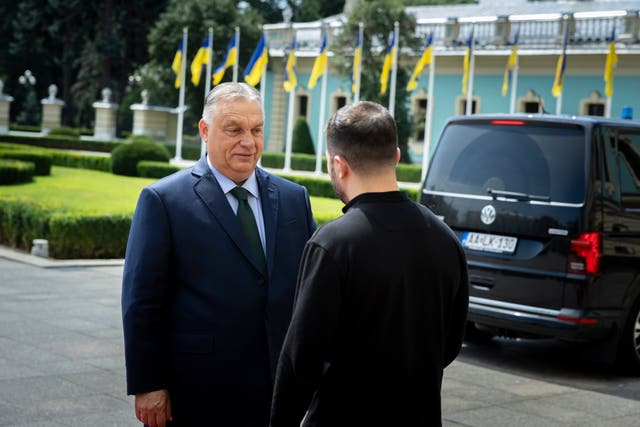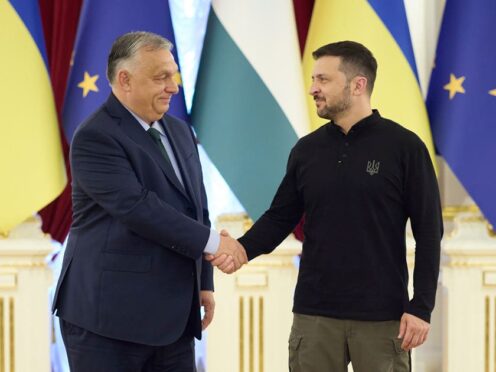During his first visit to neighbouring Ukraine since Russia’s full-scale invasion, Hungarian Prime Minister Viktor Orban told President Volodymyr Zelensky on Tuesday that the war was Europe’s “most important issue”, and recommended an immediate ceasefire.
Mr Orban is widely seen as having the warmest relations with Russian President Vladimir Putin among European Union leaders, and his visit was a rare gesture in a tumultuous relationship with Ukraine as Budapest has repeatedly leaned toward Moscow.
The Hungarian prime minister has routinely blocked, delayed or watered down EU efforts to extend assistance to Ukraine and to sanction Moscow over its war, frustrating both Mr Zelensky and other EU leaders.
But following talks in Kyiv on Tuesday, Mr Orban appeared to open the door to a new phase of bilateral relations, saying “the time had come” for such an official visit.

“We are trying to leave the disputes of the past behind us and focus on the period ahead,” Mr Orban said in brief comments to journalists following the talks.
“We would like relations between our two countries to be much better.”
Ukraine and Hungary have had a tense relationship since the war began, with Mr Orban portraying himself as a champion for peace and calling for an immediate ceasefire and peace talks without expanding on what that would mean for Ukraine’s territorial integrity.
He reiterated that call on Tuesday, saying it would “provide an opportunity to speed up peace negotiations”.
But Mr Zelensky on Tuesday said he was “grateful” for the humanitarian support Hungary had provided to Ukrainian refugees fleeing the war.
He also said Hungary could play a role in organising a second iteration of a peace summit that was held in Switzerland last month, which brought together dozens of world leaders.
“Today, we discussed in detail how Hungary can show further leadership in preparing the second summit,” Mr Zelensky said, adding that he would like for the event to take place this year.
Mr Orban’s visit comes the day after Hungary took over the six-month rotating presidency of the EU, a position that has little real power but can be used to set the tone of the bloc’s agenda.
Hungarian officials have indicated that they will act as “honest brokers” in the role despite worries from some EU lawmakers that Hungary’s democratic track record makes it unfit to lead the bloc.
During the visit, the Hungarian prime minister acknowledged Russia’s invasion, and said his aim in travelling to Kyiv was “to understand how we could be helpful to Ukraine in the forthcoming six months”.
“The issue of peace is not only important for Ukraine, it is important for the whole of Europe,” Mr Orban said.
“This war, which you are now suffering, has a profound effect on European security.”
The war is “the most important issue for Europe”, he said.
The Hungarian leader, a self-described adherent of “illiberal democracy”, has long been accused by his European partners of dismantling democratic institutions at home and acting as an obstinate spoiler of key EU policy priorities.
The bloc has frozen more than 20 billion dollars (£15.8 billion) in funding to Budapest over alleged rule-of-law and corruption violations, and Mr Orban has conducted numerous anti-EU campaigns depicting it as an overcentralised, repressive organisation.
Mr Orban has also long accused Kyiv of mistreating an ethnic Hungarian minority in Ukraine’s western region of Zakarpattia, a community he has used to justify his refusal to provide weapons to Ukraine or allow their transfer across the two countries’ shared border.
But on Tuesday, Mr Orban said he sees a “good chance” of achieving progress in the minority community’s affairs, and agreed to a proposal by Mr Zelensky to set up a Ukrainian school in Hungary for refugees.
“These families need to be taken care of. They need jobs, they need a livelihood, they need security, they need a good school for their children, they need good teachers,” Mr Orban said.
His visit comes as he seeks to recruit members into a new nationalist alliance that he hopes will soon become the largest right-wing group in the European Parliament.
On Sunday, Mr Orban met in Vienna with the leaders of Austria’s far-right Freedom Party and the main Czech opposition party, announcing the formation of the new group, “Patriots for Europe”.
The trio would need to attract politicians from at least four more EU countries to successfully form a group in Europe’s new parliament, which held elections in June.
Right-wing nationalist parties across Europe strengthened their position in the elections, but ideological differences over the war in Ukraine and co-operation with Russia have often prevented deeper alliances among some of the parties.
